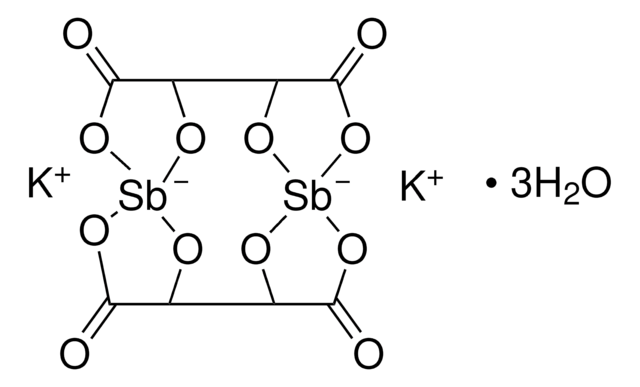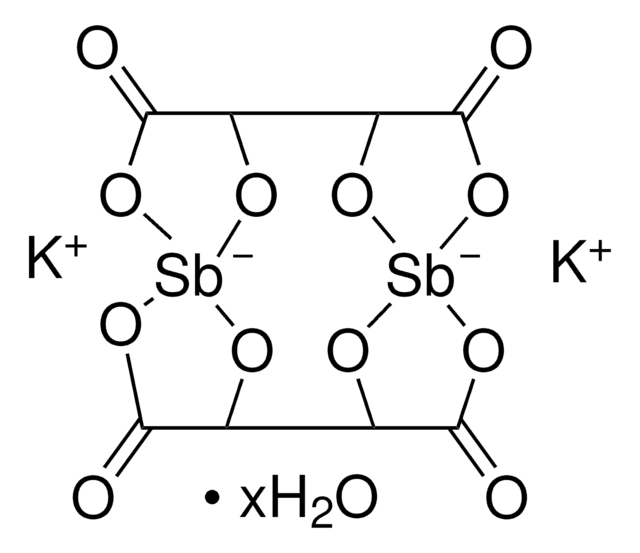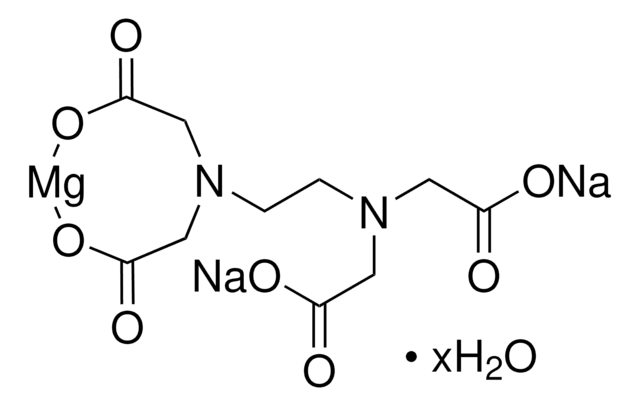60063
Potassium antimonyl tartrate trihydrate
purum p.a., 99.0-103% (RT)
Synonym(s):
Antimony potassium tartrate trihydrate, Tartar emetic
About This Item
Recommended Products
grade
purum p.a.
Quality Level
Assay
99.0-103% (RT)
loss
≤2.7% loss on drying
mp
≥300 °C (lit.)
anion traces
chloride (Cl-): ≤100 mg/kg
sulfate (SO42-): ≤500 mg/kg
cation traces
Ca: ≤50 mg/kg
Cd: ≤50 mg/kg
Co: ≤50 mg/kg
Cu: ≤50 mg/kg
Fe: ≤50 mg/kg
Na: ≤500 mg/kg
Ni: ≤50 mg/kg
Pb: ≤50 mg/kg
Zn: ≤50 mg/kg
SMILES string
O.O.O.[K+].[K+].O=C1O[Sb-]23OC1C4O[Sb-]5(OC(C(O2)C(=O)O3)C(=O)O5)OC4=O
InChI
1S/2C4H4O6.2K.3H2O.2Sb/c2*5-1(3(7)8)2(6)4(9)10;;;;;;;/h2*1-2H,(H,7,8)(H,9,10);;;3*1H2;;/q2*-2;2*+1;;;;2*+3/p-4
InChI key
WBTCZEPSIIFINA-UHFFFAOYSA-J
Looking for similar products? Visit Product Comparison Guide
General description
Application
Signal Word
Danger
Hazard Statements
Precautionary Statements
Hazard Classifications
Acute Tox. 3 Oral - Acute Tox. 4 Inhalation - Aquatic Chronic 2 - Skin Irrit. 2 - Skin Sens. 1
Storage Class Code
6.1C - Combustible acute toxic Cat.3 / toxic compounds or compounds which causing chronic effects
WGK
WGK 3
Flash Point(F)
Not applicable
Flash Point(C)
Not applicable
Personal Protective Equipment
Regulatory Listings
Regulatory Listings are mainly provided for chemical products. Only limited information can be provided here for non-chemical products. No entry means none of the components are listed. It is the user’s obligation to ensure the safe and legal use of the product.
PDSCL
Deleterious substance
PRTR
Class I Designated Chemical Substances
ISHL Indicated Name
Substances Subject to be Indicated Names
ISHL Notified Names
Substances Subject to be Notified Names
JAN Code
60063-1KG:4548173173245
60063-VAR:
60063-250G:4548173173252
60063-BULK:
Choose from one of the most recent versions:
Already Own This Product?
Find documentation for the products that you have recently purchased in the Document Library.
Customers Also Viewed
Our team of scientists has experience in all areas of research including Life Science, Material Science, Chemical Synthesis, Chromatography, Analytical and many others.
Contact Technical Service











